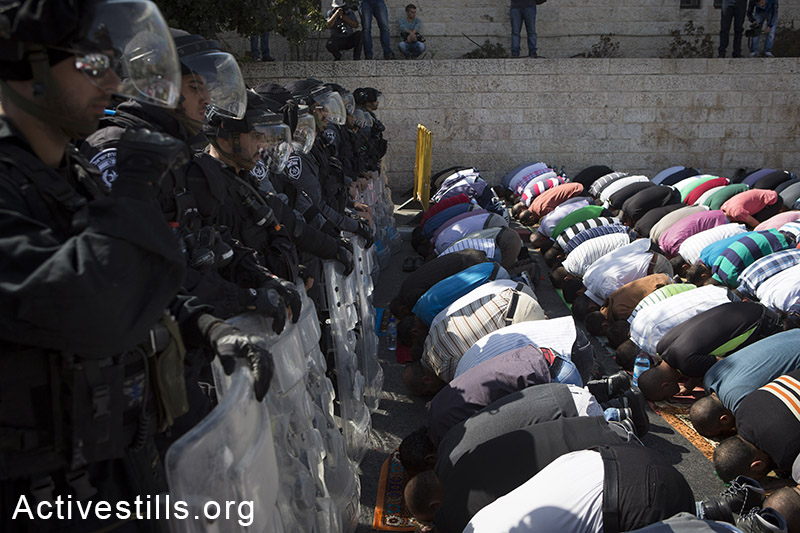It is welcome news that the long-awaited cameras will finally be installed soon. The bad news is that they don’t even touch the root of the problem — restrictions on Muslim worshippers accessing Haram al-Sharif/Temple Mount.
By Aviv Tatarsky

The issue of CCTV cameras on the Temple Mount has come up over and over again in recent weeks, and there are even reports of a final agreement between Israel and Jordan to install the cameras within the next month. Reaching such an agreement is praiseworthy, and one can only hope that the cameras help prevent another situation in which everyone — Israeli and Palestinians — loses.
But the positive attention drawn by the cameras stands in almost complete contradiction to how we have come to ignore one of the most critical factors driving the outbreak of violence in Jerusalem: restrictions Israeli authorities placed on the entry of Muslim worshippers to the Aqsa Mosque compound.
The usual explanations we hear for the violence are “provocations by Jewish Temple Mount activists” on the one hand, and “Palestinian incitement” on the other. Yet regardless of what we think and what we are told are the sources of tension, this has been an ongoing phenomenon throughout the year. Why is it, then, that violence has broken out around the High Holy Days for the past two years? And why was there no violence during the High Holy Days in 2013, despite the fact that the struggle between Temple Mount activists and their Muslim counterparts was as tense as ever?
More restrictions, more violence
Something significant changed between 2013 and 2014. Starting in June 2014, Israeli police began placing unprecedented restrictions on the entry of Muslim worshippers to Haram al-Sharif. Those restrictions, which were implemented between the Jewish holidays of Rosh Hashana and Sukkot, were imposed based on age and gender, thus negatively impacting an entire population that had never been involved in any rioting, clashes, or crime. The collective restrictions reappeared during the High Holidays in 2015.
As far as the police are concerned, the collective restrictions were borne of security concerns. But the results, in reality, had an unequivocal and opposite consequence: reinstitution restrictions on access to Al-Aqsa on the eve of Rosh Hashana, on September 13, immediately led to the outbreak of violence, which spread rapidly from the closed-off Temple Mount through the alleyways of the Old City and throughout the streets of East Jerusalem. That same night the first Israeli was killed in the current wave of violence when Palestinian youths in Sur Baher threw stones at his car. The violence worsened as the mass restrictions on entry to Al-Aqsa remained in place, leading up to the first deadly stabbing on Ha-Gai Street, or Al-Wad Street in Arabic. After that things began to spiral out of control.
It may have been more difficult in 2014 to see the connection between attacks by Palestinians and the restrictions on access to Al-Aqsa, especially considering that the violence actually broke out months earlier with the murder of Muhammad Abu Khdeir and continued throughout the war that summer. As the war ended, there were signs that the violence in Jerusalem was also tapering off. but those signs were quickly buried in a violent escalation and a series of attacks when restrictions were imposed once again for the Jewish High Holidays in September. The one thing that is impossible to ignore is that when Israeli authorities decided to lift all of the restrictions on entry for Muslim worshippers to Al-Aqsa in November 2014, the attacks and violence stopped.
The repeated imposition of restrictions on access for Muslim worshippers to Al-Aqsa is something that has only taken place over the past two years. That change can be attributed to Culture Minister Miri Regev (who at the time was chairwoman of the Knesset Internal Affairs Committee), then MK Moshe Feiglin, and the other members of Knesset who were supportive of the Temple Mount Movement. In the previous Knesset, they put great effort into changing Israeli police policy on the Temple Mount, ultimately leading to the police’s unprecedented closure of the holy site to large Muslim populations for days on end.
Boomerang effect
For the Muslim population, in addition to the anger about closing Al-Aqsa Mosque, those restrictions were understood to be related to the MKs’ and Temple Mount Movement activists’ declared intentions to divide the holy site between Jews and Muslims. Admittedly, preventing the entry of Muslim worshippers while granting access to Jewish visitors is inconsistent with the concept of giving preference to worshippers over visitors. And that would be contradictory with the status quo to which Netanyahu committed, and makes Palestinian grievances all the more grounded.
An examination of the situation on the ground demonstrates that keeping specific Muslim rioters off the Temple Mount passed relatively quietly. Even when Israeli police were forced to clash with young Palestinians, who blockaded themselves inside the mosque with stockpiles of stones, the situation would calm down almost immediately after the clashes ended. But closing off the Haram al-Sharif/Temple Mount to entire Muslim populations achieves the opposite effect.
None of that is meant to justify the violence of the past few months. However, the matter of collective restrictions must be raised, and in light of their disastrous consequences, the police must find alternative strategies and tactics. Unfortunately, while the cameras are being installed in Haram al-Sharif/Temple Mount to record all that takes place inside it, everything happening at the gates and checkpoints, out of range of the cameras, all that which is setting the city alight, is pushed out of view and the public discourse surrounding Al-Aqsa. We need have that conversation if we want to stop the next round of violence, certainly ahead of this year’s Jewish High Holidays.

